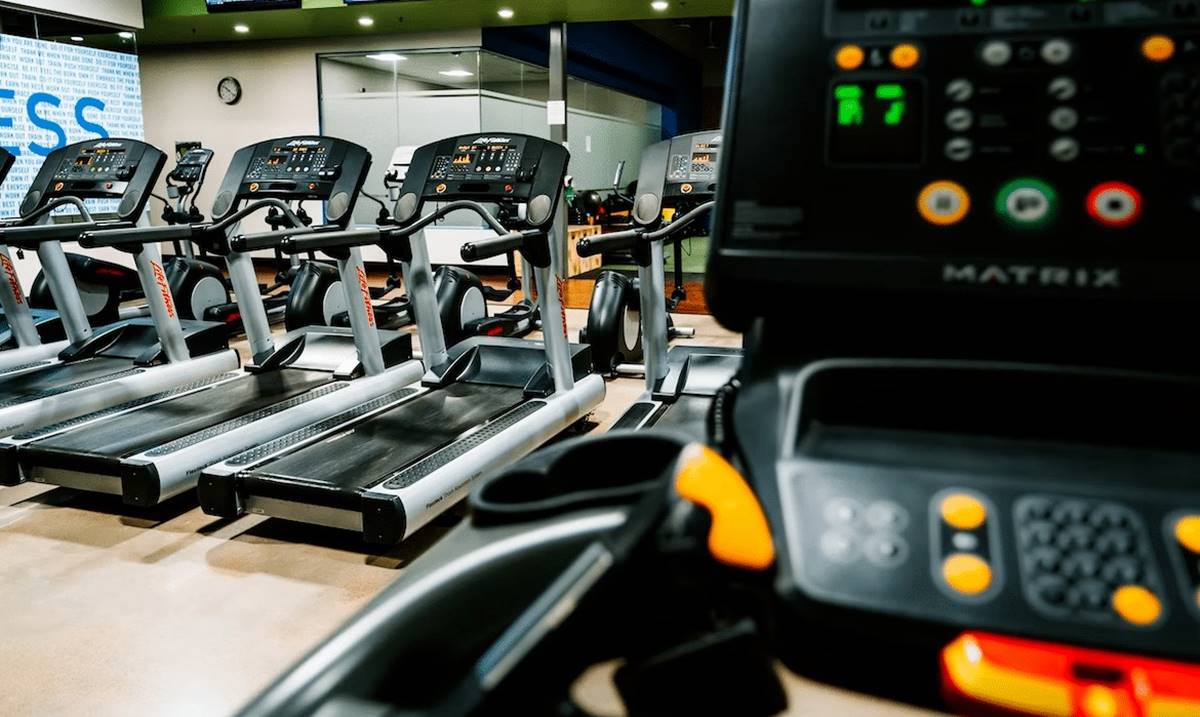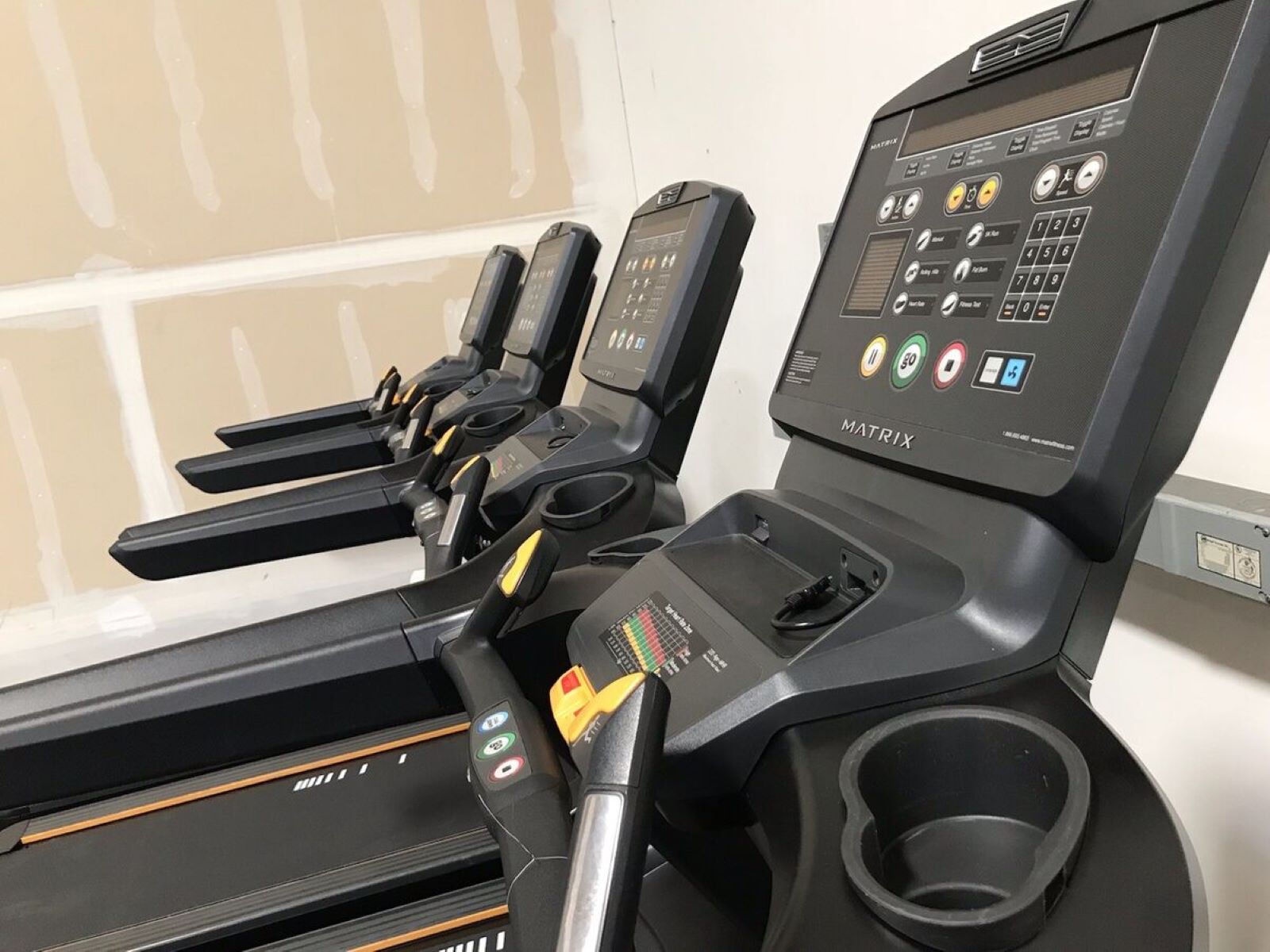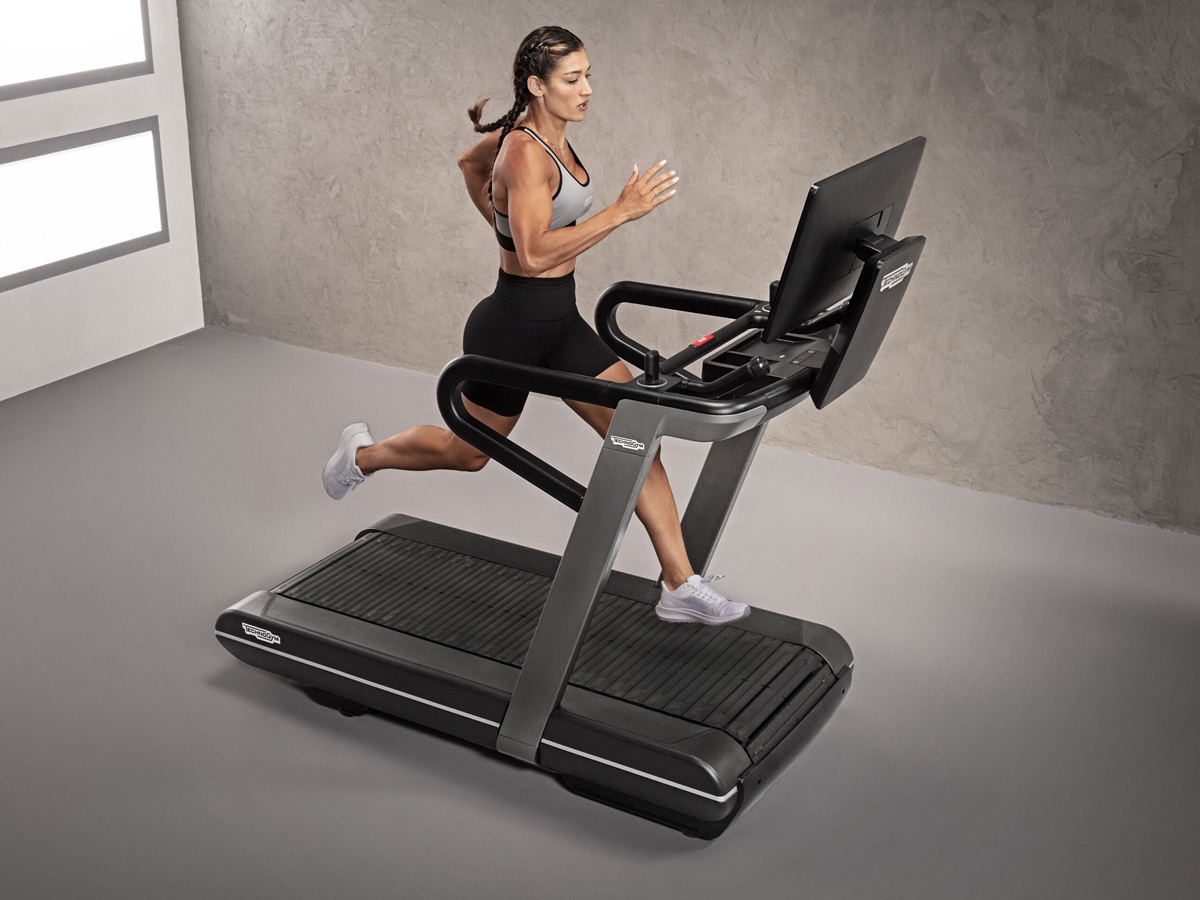

Featured
How To Increase Stamina On Treadmill
Modified: January 22, 2024
Discover the top tips and exercises to increase your stamina on the treadmill. Find out how to reach your fitness goals and become a featured athlete!
Introduction
Welcome to the world of treadmill running, where endurance and stamina play a vital role in achieving your fitness goals. Whether you are a beginner or a seasoned runner, increasing your stamina on a treadmill can significantly enhance your cardiovascular fitness and overall endurance. It is not only crucial for improving your performance on the treadmill but also for boosting your overall fitness levels.
Running on a treadmill offers several advantages, such as providing a controlled environment, allowing you to adjust and monitor your speed, and minimizing the impact on your joints. However, it can also be a challenging endeavor, especially if you struggle with stamina. The good news is that with the right strategies and consistent training, you can gradually build up your endurance and tackle longer distances without feeling exhausted.
In this article, we will explore various techniques and tips to increase your stamina on a treadmill. Whether you are training for a marathon, looking to lose weight, or simply aiming to improve your cardiovascular health, these methods will help you push your boundaries, break through plateaus, and achieve your fitness objectives.
So, grab your water bottle, put on your running shoes, and let’s dive into the world of increasing stamina on a treadmill!
Importance of Stamina on Treadmill
Having good stamina is essential for anyone who wants to make the most of their treadmill workouts. Stamina refers to your ability to sustain physical activity for an extended period without getting tired or fatigued. When it comes to running on a treadmill, having sufficient stamina can greatly improve your performance, endurance, and overall fitness.
First and foremost, building stamina on a treadmill allows you to run for longer periods of time without feeling exhausted. This means you can cover greater distances and burn more calories, which is beneficial if your goal is weight loss or improving your cardiovascular health. Increasing your stamina also enables you to challenge yourself with higher intensity workouts, such as interval training or hill sprints, which can lead to greater cardiovascular fitness gains.
Moreover, having good stamina on a treadmill helps you develop mental resilience and discipline. Running for extended periods requires mental focus and determination, and the ability to push through physical discomfort. By consistently working on your stamina, you can cultivate these mental attributes and apply them to other areas of your life.
In addition, improving your stamina on a treadmill can enhance your performance in other sports or physical activities. Whether you enjoy playing soccer, basketball, or simply want to keep up with your kids at the park, having better cardiovascular endurance gained from treadmill running can give you a competitive edge and help prevent fatigue during various physical activities.
Lastly, running on a treadmill is a convenient and accessible way to improve your cardiovascular fitness regardless of the weather or time constraints. By focusing on enhancing your stamina, you can make the most of your treadmill workouts and stay consistent with your training even when outdoor running is not an option.
To sum up, developing stamina on a treadmill brings a host of benefits, including increased endurance, improved physical performance, mental resilience, and better overall fitness. It is an essential component of any cardio-focused fitness routine and can support you in achieving your goals, whether they are related to weight loss, cardiovascular health, or general physical fitness.
Tips for Increasing Stamina on Treadmill
Increasing your stamina on a treadmill requires a combination of consistency, proper training techniques, and understanding your body’s limits. Here are some tips to help you boost your endurance and improve your performance:
- Warm-Up Exercises: Start your treadmill session with a dynamic warm-up routine that includes movements such as lunges, high knees, and leg swings. This will prepare your muscles, increase blood flow, and loosen up your joints.
- Gradual Build-Up: If you’re just starting out or have low fitness levels, begin with shorter treadmill sessions and gradually increase the time and intensity. Over time, your body will adapt and become more efficient at oxygen utilization, allowing you to run for longer periods without feeling tired.
- Interval Training: Incorporate interval training into your treadmill workouts. Alternate between periods of high intensity (such as sprinting or running at a faster pace) and periods of low intensity (such as walking or jogging). This method challenges your cardiovascular system and helps build stamina over time.
- Incorporating Incline: Set your treadmill to an incline to simulate running uphill. This engages more muscle groups and increases the intensity of your workout, thereby improving your stamina. Gradually increase the incline as your fitness level improves.
- Proper Breathing Techniques: Pay attention to your breathing while running on the treadmill. Practice deep belly breathing, inhaling through your nose and exhaling through your mouth. This helps deliver oxygen to your muscles more efficiently and reduces the feeling of fatigue.
- Strength Training Exercises: Include strength training exercises in your fitness routine to build muscle endurance. Focus on exercises that target your lower body, such as squats, lunges, and calf raises. Strong leg muscles will support your running performance and improve overall stamina.
- Hydration and Nutrition: Stay hydrated before, during, and after your treadmill workouts. Drink water regularly to replace lost fluids and maintain optimal performance. Additionally, fuel your body with a balanced diet that includes carbohydrates for energy, protein for muscle repair, and healthy fats for sustained energy levels.
- Rest and Recovery: Give your body enough time to rest and recover between treadmill sessions. This allows your muscles to repair and grow stronger. Overtraining can lead to burnout and injury, so listen to your body’s cues and take rest days when needed.
These tips will help you gradually increase your stamina on a treadmill and improve your overall fitness. Remember to be patient with yourself, as building endurance takes time and dedication. With consistent training and the right approach, you’ll be amazed at how quickly your stamina improves and how much longer you can run on that treadmill!
Warm-Up Exercises
Before you hop on the treadmill and start running, it’s crucial to properly warm up your body. A dynamic warm-up routine will gradually increase your heart rate, warm up your muscles, and prepare your body for the workout ahead. Here are some warm-up exercises to incorporate into your treadmill routine:
- Leg Swings: Stand next to a wall or hold onto a sturdy object for balance. Swing one leg forward and backward, aiming to progressively increase the range of motion with each swing. Repeat for 10-15 swings on each leg. This exercise helps to loosen up your hip flexors and hamstrings.
- Walking Lunges: Step forward with your right foot and lower your body into a lunge position, keeping your knee directly above your ankle. Push through your right heel to return to the starting position and repeat with the left leg. Perform 10-12 lunges on each leg. This exercise activates your glutes, quadriceps, and hamstrings.
- High Knees: Stand with your feet hip-width apart. Lift your right knee towards your chest, simultaneously raising your left arm. Lower your leg and repeat with the left knee and right arm. Continue alternating for 30 seconds to 1 minute. High knees increase your heart rate and engage your core, hip flexors, and leg muscles.
- Butt Kicks: Stand with your feet hip-width apart and slightly bend your knees. Start jogging in place, kicking your heels towards your glutes. Maintain a smooth and controlled movement, aiming to make contact between your heels and glutes. Perform butt kicks for 30 seconds to 1 minute. This exercise helps to warm up your quadriceps and calves.
- Arm Circles: Extend your arms out to the sides, parallel to the ground. Begin making small circles with your arms, gradually increasing the size of the circles. After 15-20 seconds, reverse the direction of the circles. This exercise warms up your shoulder joints and upper body muscles.
- Jumping Jacks: Stand with your feet together and arms by your sides. Jump, spreading your feet wider than shoulder-width apart and simultaneously raising your arms overhead. Jump again, and return to the starting position. Repeat for 30 seconds to 1 minute. Jumping jacks increase your heart rate and warm up your entire body.
By incorporating these warm-up exercises into your treadmill routine, you’ll activate and mobilize key muscle groups, improve blood circulation, and reduce the risk of injury. It only takes a few minutes, but the benefits are significant. So, don’t skip your warm-up – it’s an essential step to ensure a safe and effective treadmill workout!
Gradual Build-Up
When it comes to increasing your stamina on a treadmill, it’s important to start gradually and build up your endurance over time. Pushing yourself too hard or attempting to run at a higher intensity than your current fitness level can lead to burnout or even injuries. Here are some tips for a gradual build-up:
- Set Realistic Goals: Begin by setting achievable goals based on your current fitness level. For example, if you can comfortably run for 10 minutes at a moderate pace, aim to increase your running time gradually by 1-2 minutes each week.
- Follow the 10% Rule: Stick to the 10% rule, which suggests increasing your weekly mileage or running time by no more than 10%. This gradual progression allows your body to adapt to the increased demands and reduces the risk of overuse injuries.
- Monitor Your Heart Rate: Pay attention to your heart rate during your workouts. Your heart rate is a reliable indicator of the intensity of your exercise. Gradually increase the intensity by keeping your heart rate within a target range that challenges you but still allows you to maintain a conversation.
- Alternate Walking and Running: If you’re new to treadmill running or have low stamina, consider incorporating intervals of walking and running. Start by running for a few minutes and then walking for a minute to recover. As your stamina improves, gradually increase the running intervals and reduce the walking intervals.
- Patience and Consistency: Increasing your stamina takes time and consistency. Be patient with yourself and trust the process. Stick to a regular running schedule and gradually increase your running time or distance over weeks and months.
- Listen to Your Body: Pay attention to how your body feels during and after your treadmill workouts. If you experience pain, excessive fatigue, or any signs of injury, take a step back and allow yourself more time to recover. Pushing through pain can lead to more serious problems in the long run.
Remember, the key to a gradual build-up is to increase your running time or distance at a pace that is comfortable for you. By progressing slowly and steadily, your body will adapt and become more efficient at utilizing oxygen, improving both your stamina and endurance over time.
It’s important to enjoy the process and celebrate each milestone along the way. Don’t compare yourself to others or get discouraged if progress seems slow. Every small step forward is a step in the right direction towards improving your stamina on a treadmill.
Interval Training
Interval training is a highly effective method for increasing stamina on a treadmill. It involves alternating between periods of high-intensity exercise and active recovery or low-intensity exercise. By incorporating interval training into your treadmill workouts, you can boost your cardiovascular fitness, improve endurance, and elevate your overall performance. Here’s how to make the most of interval training:
- Choose Your Intervals: Determine the duration and intensity of your high-intensity intervals. For beginners, start with shorter intervals, such as 30 seconds of running at a faster pace, followed by one to two minutes of active recovery, such as light jogging or walking. As your fitness level improves, gradually increase the duration and intensity of your high-intensity intervals.
- Vary the Intensity: Experiment with different intensity levels during your high-intensity intervals. You can incorporate sprints, increase the speed, or add incline to challenge your cardiovascular system. The goal is to elevate your heart rate and push your body outside its comfort zone.
- Recover Properly: During the active recovery or low-intensity periods, allow your heart rate to lower slightly before the next high-intensity interval. Use this time to catch your breath, hydrate, and mentally prepare for the next interval.
- Progress Gradually: As with any training approach, it’s essential to progress gradually with interval training. Start with one or two intervals per workout and gradually increase the number of intervals as your stamina improves. Remember, quality over quantity is key.
- Mix Up Your Workouts: Prevent boredom and keep your body challenged by varying your interval workouts. You can change the duration and intensity of the intervals, incorporate different running speeds, or try different types of interval workouts, such as pyramid intervals or ladder intervals.
- Monitor Your Progress: Keep track of your interval training progress. Record the duration and intensity of your intervals, as well as your recovery periods. This way, you can track your improvements over time and adjust your training accordingly.
Interval training on a treadmill not only helps improve your stamina but also increases your aerobic capacity, strengthens your heart, and burns more calories in a shorter period. It’s a time-efficient way to maximize your treadmill workouts and push your limits.
Remember to listen to your body during interval training. If you experience excessive fatigue or pain, it’s important to reduce the intensity or duration of your intervals and gradually work your way up. Consistency, patience, and proper progression are key to safely and effectively increasing your stamina through interval training.
Incorporating Incline
Incorporating incline into your treadmill workouts is a fantastic way to increase stamina and challenge your cardiovascular system. Running on an incline engages different muscle groups, elevates your heart rate, and mimics the resistance of running uphill. Here’s how to effectively incorporate incline into your treadmill workouts:
- Gradual Incline Increase: Start with a low incline, such as 1% or 2%, and gradually increase it as your stamina improves. This allows your body to adjust to the added challenge and prevents excessive strain or fatigue.
- Simulate Hills: To mimic the experience of running uphill, adjust the incline of your treadmill to a steeper setting. This engages your glutes, hamstrings, and calves more intensely and requires greater effort from your cardiovascular system.
- Interval Incline Training: Combine interval training with incline training for a more challenging workout. Alternate between periods of running/walking on an incline and active recovery on a flat surface. This helps build stamina, as well as strengthen and tone your lower body muscles.
- Focus on Posture: When running on an incline, maintain good posture by standing tall, keeping your shoulders relaxed, and engaging your core muscles. This promotes proper alignment and more efficient running mechanics, allowing you to sustain your stamina for longer periods.
- Use a Variety of Incline Levels: Experiment with different incline levels during your workouts. You can mix shorter intervals at a higher incline with longer periods at a lower incline. This variation helps prevent boredom and continuously challenges your cardiovascular system.
- Hydrate and Cool Down: Running on an incline increases the intensity of your workout and causes you to sweat more. Stay hydrated by drinking water before, during, and after your treadmill session. Additionally, remember to cool down and stretch your muscles after to promote recovery.
Incorporating incline into your treadmill workouts not only improves your stamina but also strengthens your lower body muscles, including your glutes, hamstrings, and calves. It provides a fantastic way to add variety to your training routine and simulates the experience of running outdoors on different terrains.
As with any training method, it’s important to progress gradually when incorporating incline into your treadmill workouts. Start with a comfortable incline level and gradually increase it over time. Listen to your body and adjust the intensity based on your fitness level and comfort.
Remember, the key to increasing stamina through incline training is to challenge yourself without overexerting. With consistent practice, you’ll not only improve your endurance on the incline but also enhance your overall treadmill running performance.
Proper Breathing Techniques
Proper breathing techniques play a crucial role in improving stamina on a treadmill. Efficient breathing helps deliver oxygen to your muscles, reduce fatigue, and enhance endurance. Here are some tips to help you master proper breathing techniques while running on a treadmill:
- Deep Belly Breathing: Focus on deep belly breathing rather than shallow chest breathing. Inhale deeply through your nose, allowing your belly to expand, and then exhale fully through your mouth. This technique maximizes oxygen intake and helps remove carbon dioxide from your body.
- Match Breathing with Strides: Coordinate your breathing with your strides. Some runners find it helpful to inhale for a certain number of steps and exhale for the same number of steps. Experiment to find the rhythm that feels natural to you.
- Rhythmic Breathing: Practice rhythmic breathing by establishing a consistent pattern. For example, inhale for three steps and then exhale for three steps. This steady rhythm helps you maintain a consistent breathing pattern, which in turn enhances your stamina and running efficiency.
- Breathe Through Your Nose and Mouth: Inhale through both your nose and mouth to maximize the airflow and oxygen intake. This technique is especially useful during intense intervals or when you need additional oxygen supply.
- Focus on Relaxation: Keep your jaw, neck, and shoulders relaxed while running. Tension in these areas can restrict your breathing and increase fatigue. Be aware of any tightness and consciously release the tension as you run.
- Practice Diaphragmatic Breathing: Strengthen your diaphragm muscle by practicing diaphragmatic breathing techniques outside of running. Lie down and place one hand on your chest and the other on your abdomen. Inhale deeply, filling your abdomen with air, while keeping your chest relatively still. Exhale fully to empty your abdomen of air. This exercise helps develop a habit of using your diaphragm for deeper breaths while running.
By practicing proper breathing techniques, you can optimize your oxygen intake, improve your respiratory efficiency, and reduce the feeling of fatigue while running on a treadmill. Incorporate these techniques into your training, and you’ll notice a significant improvement in your stamina and endurance.
Remember that breathing is a natural process, but it can be adjusted and fine-tuned to enhance your running performance. Experiment with different techniques and find what works best for you. Over time, proper breathing techniques will become second nature, allowing you to run longer, stronger, and with greater ease on the treadmill.
Strength Training Exercises
Incorporating strength training exercises into your fitness routine is a game-changer when it comes to increasing your stamina on a treadmill. Building strength in your lower body muscles and core not only supports your running form and reduces the risk of injury but also enhances your overall endurance. Here are some key strength training exercises to improve your treadmill stamina:
- Squats: Stand with your feet shoulder-width apart. Lower your body by bending your knees and pushing your hips back as if sitting into a chair. Keep your chest up and your back straight. Return to the starting position by pushing through your heels. Squats target your quadriceps, hamstrings, and glutes – key muscle groups for running.
- Lunges: Step forward with your right foot and lower your body until your right thigh is parallel to the ground, with your knee directly above your ankle. Push through your right heel to return to the starting position. Repeat on the left side. Lunges strengthen your quads, hamstrings, glutes, and calves.
- Calf Raises: Stand with your feet hip-width apart, and slowly rise up onto the balls of your feet while keeping your core engaged. Hold for a moment, then lower your heels back down. Calf raises target your calf muscles, which play a significant role in running and provide power during push-off.
- Glute Bridges: Lie on your back with your knees bent and feet hip-width apart. Push through your heels, activate your glutes, and lift your hips off the ground until your body forms a straight line. Hold for a moment, then lower your hips back down. Glute bridges strengthen your glutes and hamstrings, improving running efficiency and power.
- Plank: Get into a push-up position with your hands directly beneath your shoulders. Engage your core and hold your body in a straight line from head to toe. Avoid sagging or lifting your hips. Start with shorter holds and gradually increase your time. Planks strengthen your core muscles, enhancing stability and reducing energy wastage during running.
- Deadlifts: Stand with your feet hip-width apart, holding a barbell or dumbbells in front of your thighs. With a slight bend in your knees and a flat back, hinge at your hips and lower the weight towards the ground. Keep the weights close to your legs and drive up through your heels to return to a standing position. Deadlifts work your hamstrings, glutes, and lower back.
Incorporating these strength training exercises into your fitness routine two to three times per week will not only improve your overall muscular strength but also enhance your stamina on a treadmill. Stronger legs, glutes, and core muscles provide a solid foundation for improved running efficiency and endurance.
Start with proper form and lower resistance if needed. Gradually increase the weight or resistance as you become more comfortable and confident with the exercises. Consistency is key – make strength training a regular part of your fitness routine to reap the benefits of increased stamina on a treadmill.
Hydration and Nutrition
Hydration and nutrition play a vital role in improving stamina on a treadmill. Keeping your body properly fueled and hydrated ensures optimal performance, aids in recovery, and supports overall endurance. Here are some important tips to consider:
- Stay Hydrated: Hydration is key before, during, and after your treadmill workouts. Drink water regularly throughout the day to maintain proper hydration levels. During your workouts, aim to sip water every 15-20 minutes or as needed. Hydration helps regulate body temperature, lubricates joints, and transports nutrients to muscles.
- Fluid Replacement: Replenish fluids lost through sweating. If your treadmill sessions are intense or last longer than one hour, consider replenishing electrolytes by consuming a sports drink or coconut water. Electrolytes, such as sodium and potassium, help maintain proper fluid balance and aid in muscle function.
- Eat a Balanced Diet: Fuel your body with a balanced diet that includes a variety of nutrient-dense foods. Prioritize complex carbohydrates, such as whole grains, fruits, and vegetables, as they provide sustained energy for your workouts. Include lean proteins for muscle repair and growth, as well as healthy fats for long-lasting energy.
- Pre-Workout Fuel: Eat a light meal or snack about 1-2 hours before your treadmill workouts to provide your body with the necessary energy. Choose foods that are easily digestible and high in carbohydrates, such as a banana, whole-grain toast with peanut butter, or a small bowl of oatmeal.
- Post-Workout Recovery: After your treadmill sessions, prioritize post-workout nutrition to aid in recovery. Include a combination of carbohydrates and protein within 30-60 minutes of finishing your workout. This can be a protein shake, Greek yogurt with berries, or a balanced meal containing lean protein and whole grains.
- Listen to Your Body: Every individual has unique hydration and nutritional needs. Pay attention to how your body responds to different foods and fluids before, during, and after your treadmill workouts. Adjust your hydration and nutrition strategies based on your personal preferences and performance.
Proper hydration and nutrition are essential for sustaining energy levels, optimizing performance, and enhancing stamina on a treadmill. Make it a priority to fuel your body properly, both on workout days and rest days, to support your fitness goals.
Remember, everyone’s hydration and nutritional needs may vary, so it’s important to listen to your body and make adjustments accordingly. Consult with a registered dietitian or healthcare professional for personalized recommendations to ensure you’re meeting your specific requirements.
Rest and Recovery
Rest and recovery are just as important as training when it comes to increasing stamina on a treadmill. Giving your body sufficient time to recover allows for muscle repair, adaptation, and improved performance. Here are some key aspects of rest and recovery to consider:
- Rest Days: Schedule regular rest days in your training program. Rest days allow your muscles, joints, and connective tissues to recover and reduce the risk of overuse injuries. Use these days to engage in low-impact activities, such as stretching, yoga, or leisurely walks.
- Sleep: Prioritize quality sleep as it is crucial for tissue repair, hormone regulation, and overall recovery. Aim for 7-9 hours of uninterrupted sleep each night to support your body’s natural healing processes and replenish energy levels.
- Active Recovery: Engage in active recovery activities on your rest days. Light exercises like swimming, cycling, or gentle stretching can promote blood flow, reduce muscle soreness, and maintain mobility without placing excessive stress on your body.
- Stretching and Mobility: Incorporate stretching and mobility exercises into your post-workout routine. Stretching helps improve flexibility, relieve muscle tension, and enhance blood circulation. Foam rolling or using a massage ball can also be beneficial to target specific areas of tightness or discomfort.
- Listen to Your Body: Pay attention to any signs of fatigue, pain, or overtraining. If you feel excessively tired, experience persistent muscle soreness, or notice any unusual discomfort, it’s important to give yourself additional rest or seek medical advice if needed.
- Cross-Training: Include cross-training activities in your fitness routine. Engaging in low-impact exercises such as swimming, cycling, or strength training on non-treadmill days can help improve overall fitness, prevent boredom, and give your running muscles a break.
- Stay Hydrated and Eat Well: Hydration and proper nutrition also play a role in recovery. Make sure you are consuming enough water and eating a balanced diet with adequate nutrients to support your body’s recovery process.
Remember, rest and recovery are integral parts of your training program. Failing to give your body enough time to recover can lead to overtraining, fatigue, and increased risk of injury. Embrace rest days as an important component of your fitness journey, and prioritize self-care to maximize your progress and enhance your stamina on the treadmill.
Developing a balanced approach to training, rest, and recovery is key to long-term success and ongoing improvement in your treadmill workouts. Listen to your body, make adjustments as needed, and give yourself the time and care necessary to support your stamina-building goals.
Conclusion
Increasing your stamina on a treadmill is a journey that requires consistency, patience, and a combination of various strategies. By incorporating warm-up exercises, gradually building up your intensity and duration, incorporating interval training, utilizing incline, practicing proper breathing techniques, incorporating strength training exercises, paying attention to hydration and nutrition, and prioritizing rest and recovery, you can enhance your endurance and overall performance on the treadmill.
Remember that everyone’s fitness journey is unique, so it’s important to listen to your body, adjust your training as needed, and celebrate your progress along the way. As you build your stamina, you’ll not only experience improvements in your treadmill workouts but also notice enhanced endurance in other physical activities and everyday life.
Keep in mind that while increasing stamina is important, it’s equally important to enjoy the process and have fun with your treadmill workouts. Find ways to stay motivated, set realistic goals, and embrace the challenges. Ultimately, the key to success lies in finding a sustainable and balanced approach that aligns with your fitness goals and lifestyle.
So lace up your shoes, hit the treadmill, and embark on your journey to improve your stamina. With dedication, consistency, and the strategies discussed in this article, you’ll be amazed at how your endurance and overall fitness levels improve over time. Keep pushing your limits, and enjoy the incredible benefits that come with increased stamina on a treadmill!









